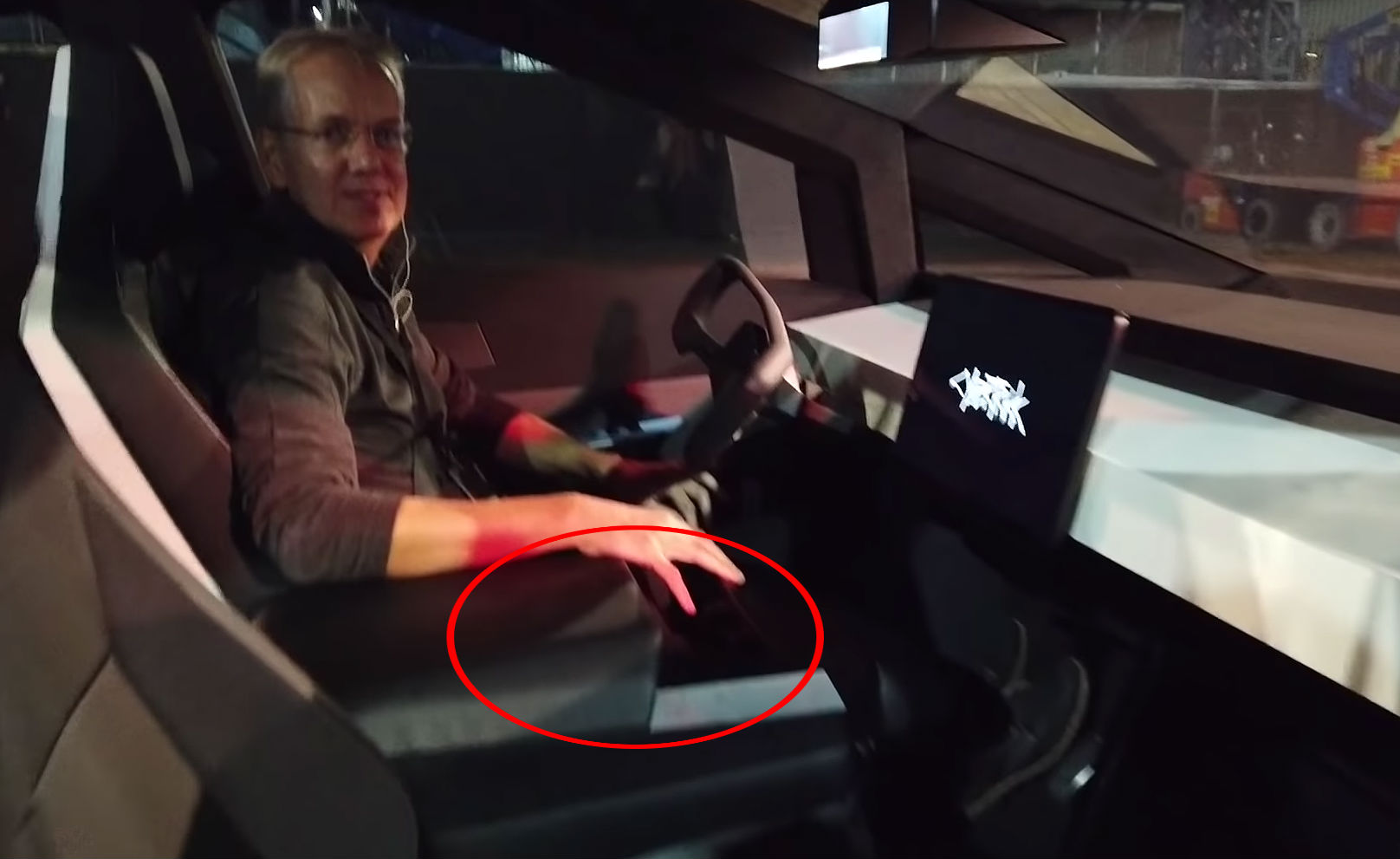
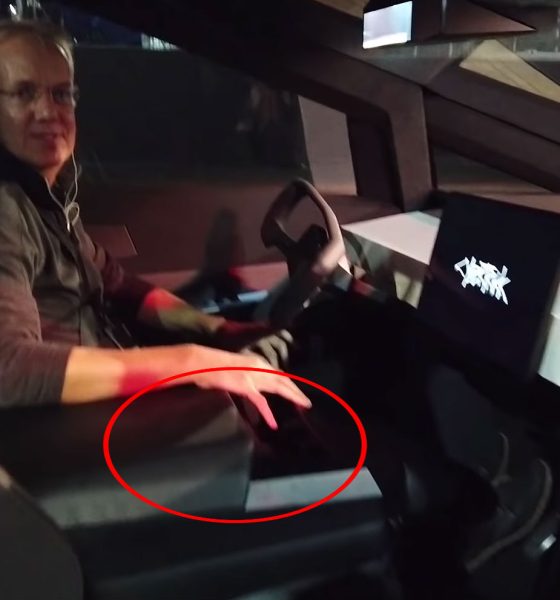
News
Top 10 Tesla Cybertruck hidden features you may have missed
The Tesla Cybertruck is loaded to the teeth with technology that the vehicle is practically a mystery box of hidden features. Couple this with the fact that the vehicle’s unveiling did not really go as planned, as well as CEO Elon Musk pretty much rushing through the truck’s presentation following the pickup’s Armor Glass demo, and many of the Cybertruck’s noatbly cool features remained unsaid.
Fortunately, some of these hidden features have been spotted by the Tesla community, thanks to photographs and videos of the vehicle taken during the unveiling event, as well as images that were released by the electric car maker in the Cybertruck’s press kit. With this in mind, following are the Tesla Cybertruck’s Top 10 hidden features that may have been missed during last week’s unveiling event. Let’s dig in.
Center Fold-Down Front Seat Cup Holders and Storage Area
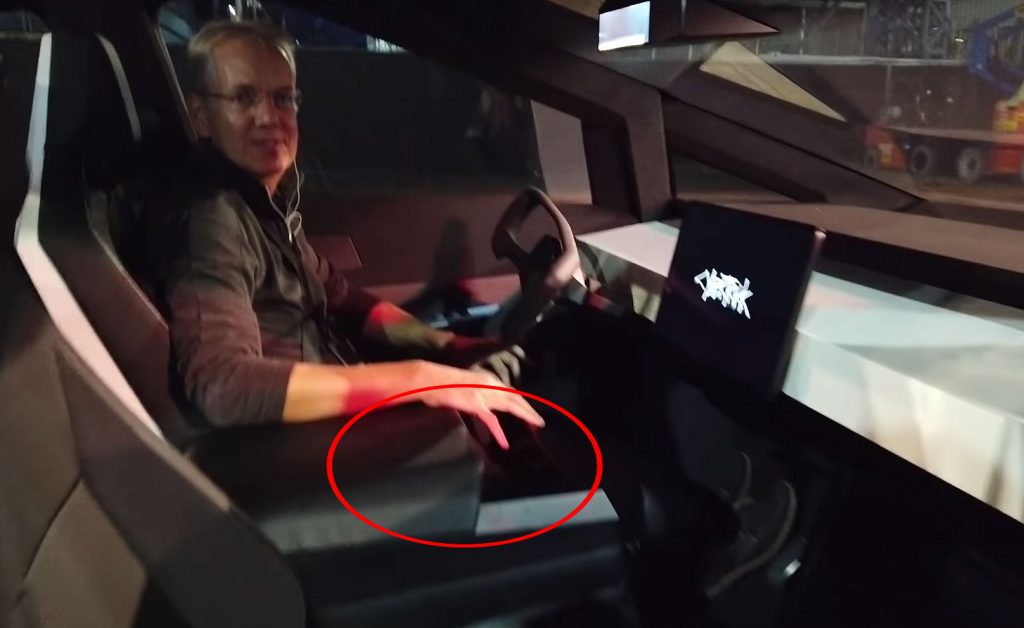
The Tesla Cybertruck is equipped with three seats on the front, though the middle acts more like a smaller jump seat. As could be seen in test ride videos of the vehicle, this middle seat actually folds down to become a large center armrest. Interestingly, this center armrest doubles as a storage compartment. It also has three cup holders that are fitted right at the middle seat’s back headrest, along with a spare change holder (aka “junk cubby”) for random knick knacks.
Interior Lighting Strip for Rear Seats
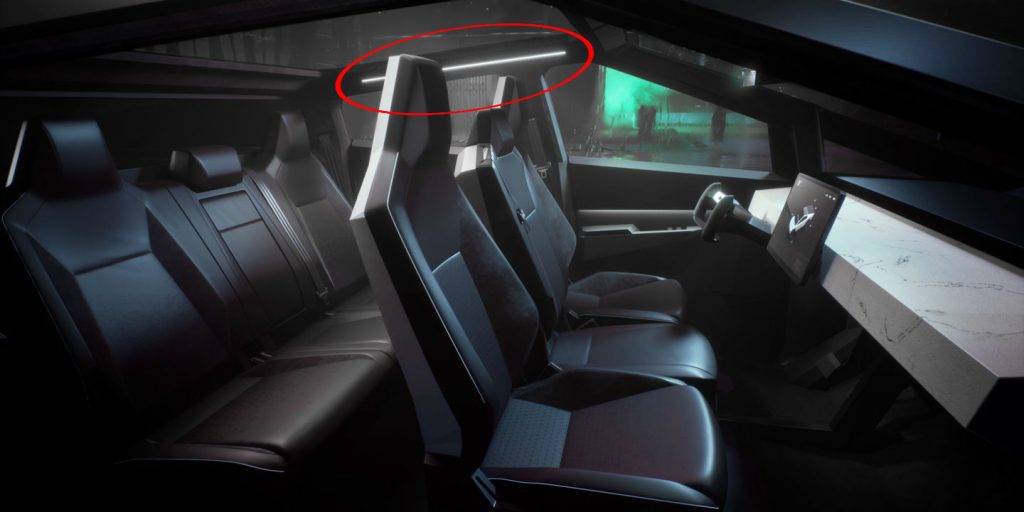
Despite its unapologetically futuristic, brutalistic exterior, the interior of the Tesla Cybertruck is actually quite welcoming. Upon entering the vehicle, passengers are greeted by a cavernous interior and a massive glass roof that would surely be a treat for those who love camping in their vehicle. The rear seats are also fitted with an interior lighting strip on the sides, providing illumination for the truck’s passengers at the back. The lights are white too, giving an additional futuristic, Tron-like flair for the Cybertruck’s exterior.
Sun Visor is Flush Against the A-Pillar
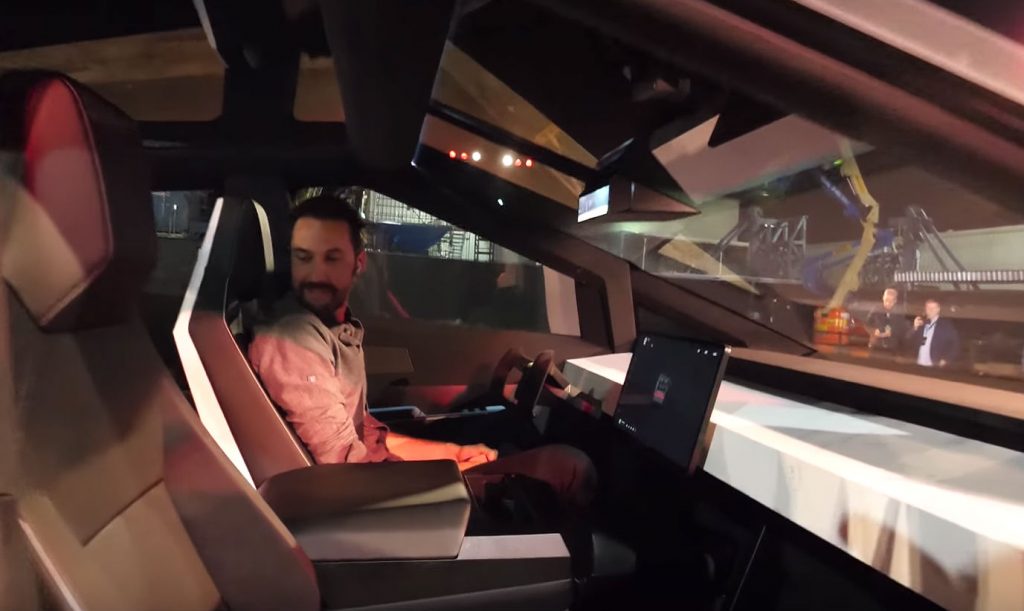
Among the clever features of the Cybertruck is its sun visor, which flushes against the A-Pillar. This would be particularly useful considering that the pickup has a massive windshield that may very well dwarf the Model X’s already-expansive windshield in sheer size.
Rear Armrest, Pass-Through for Extra-Long Cargo
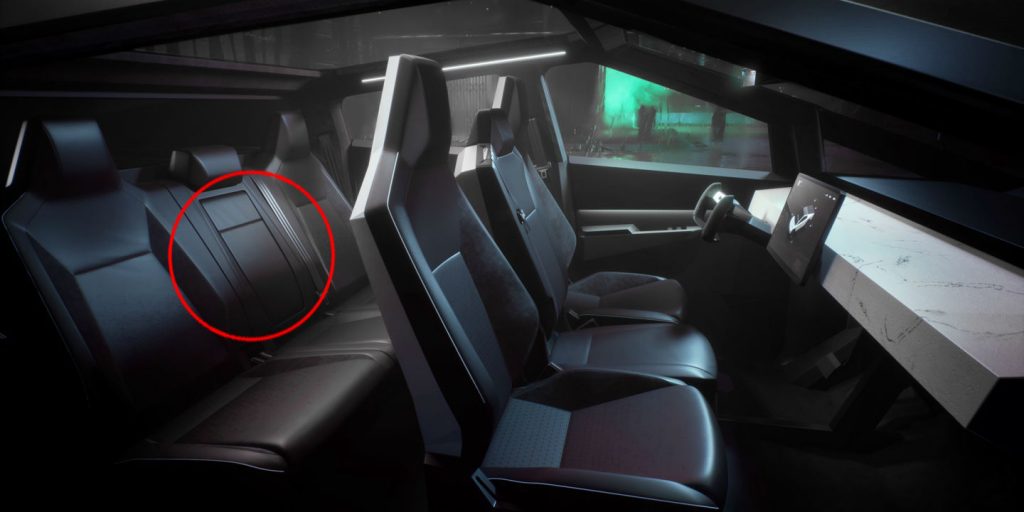
The Tesla Cybertruck has a large center armrest in the rear that looks to double as support for extra-long cargo. The all-electric pickup is already equipped with a 6.5-foot bed, which is pretty substantial, but for those who wish to haul even lengthier cargo, the center armrest can fold down and act as a pass-through for items that exceed 6.5 feet.
Scroll Wheels on the Steering Wheel
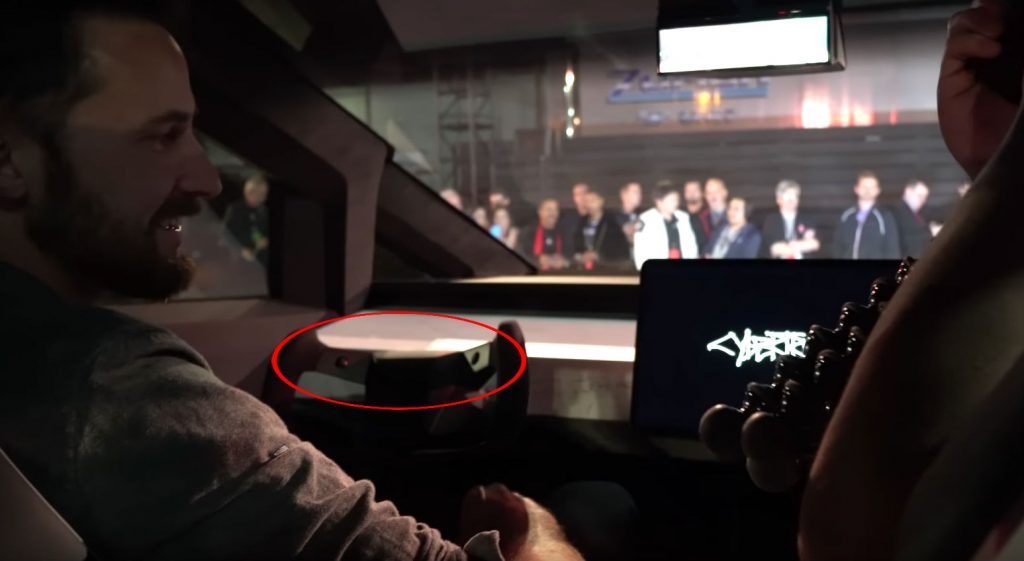
The Tesla Cybertruck is fitted with a steering yoke that looks very similar to the one used by the company in its next-generation Roadster prototype. This would likely be changed into a regular steering wheel when the vehicle enters production, but based on test rides of the pickup, it appears that the Cybertruck will utilize Model 3-esque steering wheel controls, complete with the sedan’s scroll wheels.
Autopilot Camera in Fender
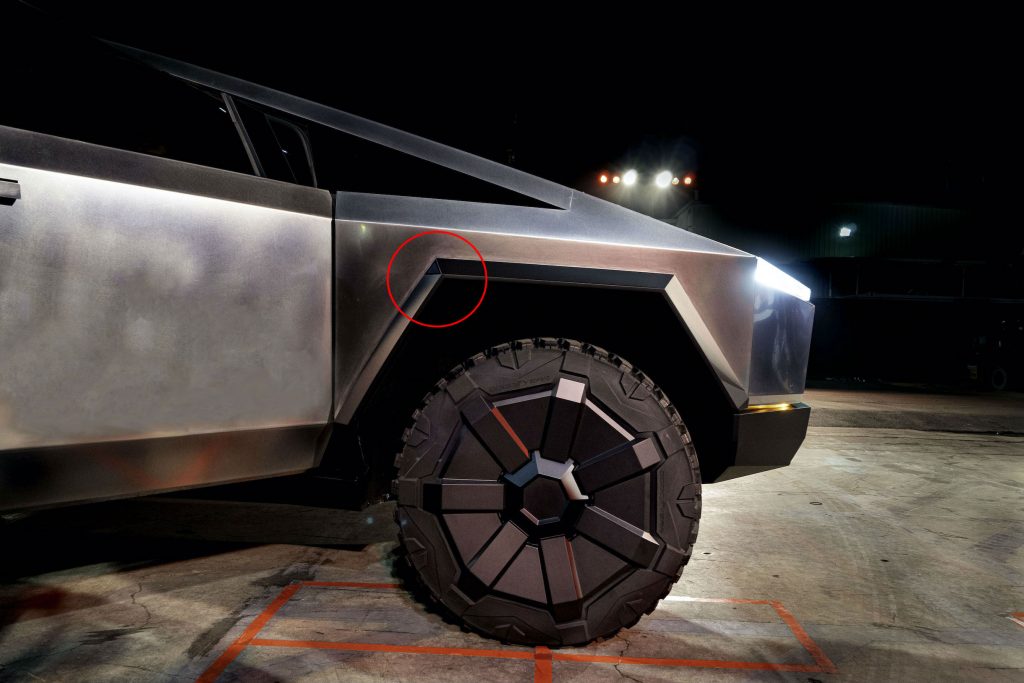
Similar to Tesla’s other prototypes like the next-generation Roadster or the Semi during its unveiling, the Cybertruck is not equipped with traditional side mirrors. Instead, the vehicle would likely use a pair of Autopilot cameras in its front fender. Considering existing regulations in regions such as the United States, there is a pretty good chance that the Cybertruck will be equipped with traditional side mirrors when it enters production.
L-Track Rails and T-Slots
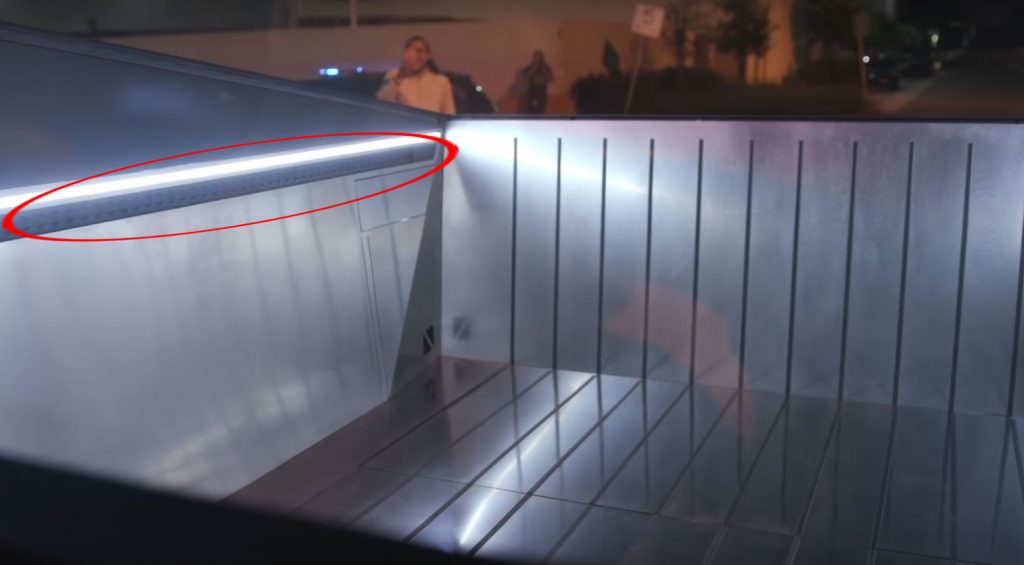
The Cybertruck is fitted with L-track rails and T-slots that allow users to place anchor points anywhere in the vehicle’s expansive 6.5-foot bed. This is key to transporting items that may otherwise move about on the pickup’s bed during transport if they are not tied down. With these components in place, Tesla Cybertruck owners would be able carry even fragile items on the rear in a secure manner.
Flush Tonneau Truck Bed Cover Activation Buttons

The Tesla Cybertruck utilizes a motorized tonneau bed cover that can be engaged and disengaged by a flush button on the vehicle’s rear. These buttons, which are notably large and easy to reach, are found on both sides of the vehicle.
Hidden storage underneath vault bed

The Tesla Cybertruck is full of storage areas, one of which is found on the bottom of the vehicle’s 6.5-foot bed itself. Based on images provided by Tesla, this space appears to be large enough to store medium-sized items such as toolboxes and sleeping bags, for those extended outdoor trips.
Hidden storage in sail pillar

For those who wish to use the Cybertuck for work, the futuristic pickup truck is fitted with a hidden storage compartment in its sail pillar. Images of the space shown during a slide at the Cybertruck’s unveiling suggest that the storage areas in the vehicle’s sail may be enough to fit some tools or similarly-sized items.

Elon Musk
Elon Musk’s xAI closes upsized $20B Series E funding round
xAI announced the investment round in a post on its official website.

xAI has closed an upsized $20 billion Series E funding round, exceeding the initial $15 billion target to fuel rapid infrastructure scaling and AI product development.
xAI announced the investment round in a post on its official website.
A $20 billion Series E round
As noted by the artificial intelligence startup in its post, the Series E funding round attracted a diverse group of investors, including Valor Equity Partners, Stepstone Group, Fidelity Management & Research Company, Qatar Investment Authority, MGX, and Baron Capital Group, among others.
Strategic partners NVIDIA and Cisco Investments also continued support for building the world’s largest GPU clusters.
As xAI stated, “This financing will accelerate our world-leading infrastructure buildout, enable the rapid development and deployment of transformative AI products reaching billions of users, and fuel groundbreaking research advancing xAI’s core mission: Understanding the Universe.”
xAI’s core mission
Th Series E funding builds on xAI’s previous rounds, powering Grok advancements and massive compute expansions like the Memphis supercluster. The upsized demand reflects growing recognition of xAI’s potential in frontier AI.
xAI also highlighted several of its breakthroughs in 2025, from the buildout of Colossus I and II, which ended with over 1 million H100 GPU equivalents, and the rollout of the Grok 4 Series, Grok Voice, and Grok Imagine, among others. The company also confirmed that work is already underway to train the flagship large language model’s next iteration, Grok 5.
“Looking ahead, Grok 5 is currently in training, and we are focused on launching innovative new consumer and enterprise products that harness the power of Grok, Colossus, and 𝕏 to transform how we live, work, and play,” xAI wrote.
Investor's Corner
Tesla gets price target bump, citing growing lead in self-driving

Tesla (NASDAQ: TSLA) stock received a price target update from Pierre Ferragu of Wall Street firm New Street Research, citing the company’s growing lead in self-driving and autonomy.
On Tuesday, Ferragu bumped his price target from $520 to $600, stating that the consensus from the Consumer Electronics Show in Las Vegas was that Tesla’s lead in autonomy has been sustained, is growing, and sits at a multiple-year lead over its competitors.
CES 2026 validates Tesla’s FSD strategy, but there’s a big lag for rivals: analyst
“The signal from Vegas is loud and clear,” the analyst writes. “The industry isn’t catching up to Tesla; it is actively validating Tesla’s strategy…just with a 12-year lag.”
The note shows that the company’s prowess in vehicle autonomy is being solidified by lagging competitors that claim to have the best method. The only problem is that Tesla’s Vision-based approach, which it adopted back in 2022 with the Model 3 and Model Y initially, has been proven to be more effective than competitors’ approach, which utilizes other technology, such as LiDAR and sensors.
Currently, Tesla shares are sitting at around $433, as the company’s stock price closed at $432.96 on Tuesday afternoon.
Ferragu’s consensus on Tesla shares echoes that of other Wall Street analysts who are bullish on the company’s stock and position within the AI, autonomy, and robotics sector.
Dan Ives of Wedbush wrote in a note in mid-December that he anticipates Tesla having a massive 2026, and could reach a $3 trillion valuation this year, especially with the “AI chapter” taking hold of the narrative at the company.
Ives also said that the big step in the right direction for Tesla will be initiating production of the Cybercab, as well as expanding on the Robotaxi program through the next 12 months:
“…as full-scale volume production begins with the autonomous and robotics roadmap…The company has started to test the all-important Cybercab in Austin over the past few weeks, which is an incremental step towards launching in 2026 with important volume production of Cybercabs starting in April/May, which remains the golden goose in unlocking TSLA’s AI valuation.”
Tesla analyst breaks down delivery report: ‘A step in the right direction’
Tesla has transitioned from an automaker to a full-fledged AI company, and its Robotaxi and Cybercab programs, fueled by the Full Self-Driving suite, are leading the charge moving forward. In 2026, there are major goals the company has outlined. The first is removing Safety Drivers from vehicles in Austin, Texas, one of the areas where it operates a ride-hailing service within the U.S.
Ultimately, Tesla will aim to launch a Level 5 autonomy suite to the public in the coming years.
Elon Musk
Elon Musk’s Biggest Revelations on AI, Robots, and the Future of Work from the Moonshots Podcast

Elon Musk’s appearance on the Moonshots with Peter Diamandis podcast was packed with bold predictions, candid admissions, and surprising tech insights. The nearly three-hour conversation covered everything from artificial intelligence to humanoid robots, geopolitics, and the future of work. Here are the top 10 most intriguing takeaways:
-
Aggressive AGI Timeline Predictions
Musk offered a detailed view on when artificial general intelligence (AGI) could emerge, suggesting it may arrive sooner than many expect, emphasizing both transformative potential and risks.
-
U.S. vs. China in the AI Race
He discussed the strategic competition between the United States and China over AI development, noting that geopolitical dynamics will shape how and who leads in the next decades.
-
Future of Job Markets
Musk touched on how AI and automation could reshape employment, predicting massive boosts in productivity alongside potential disruptions in traditional work structures.
-
Clean Energy Transition
A recurring theme was the role of clean energy in future economies, with Musk reiterating the importance of scaling sustainable power generation and storage.
-
Humanoid Robots Are Coming
On the podcast, Musk elaborated on Tesla’s work on humanoid robots, hinting at timelines and applications that go beyond factories to general-purpose assistance.
-
Tesla Roadster “Last Human-Driven Car”
Outside the core discussion topics, Musk teased features of the upcoming Tesla Roadster — calling it “the best of the last of the human-driven cars” and suggesting safety won’t be its main selling point.
-
The Role of AI in Clean Energy and Robotics
Linking AI to both energy optimization and robotics, Musk explained how smarter systems could accelerate decarbonization and task automation across industries.
-
U.S. Innovation Leadership
Musk argued that maintaining American leadership in key tech sectors like AI, space, and robotics should be a national priority, with thoughtful policy and investment.
-
Job Creation vs. Job Elimination
While acknowledging automation’s disruptive effects, he also outlined scenarios where new industries and opportunities could emerge, particularly in AI, space, and advanced manufacturing.
-
Long-Term Vision for Humanity
Throughout the conversation, Musk revisited his long-term philosophical views — including a belief in humanity’s responsibility to become a multi-planetary and technologically empowered species.
Whether you agree with Musk’s optimism or not, the podcast offers a window into the thinking of one of the most influential figures in tech today, in and why his visions continue to spark debate and inspiration.








